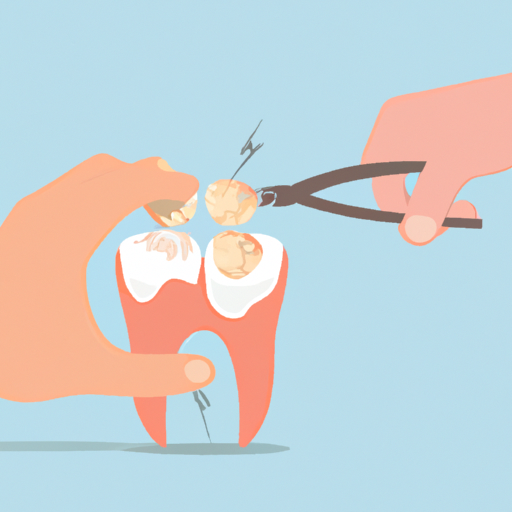Dental injuries can occur unexpectedly and can have a significant impact on our overall oral health. From minor chips and cracks to severe fractures and avulsions, understanding the causes, symptoms, and appropriate treatment for dental injuries is crucial for maintaining a healthy and functional smile. In this article, we will explore the various aspects of dental injuries, including their common causes, symptoms, and the diagnostic methods used by dental professionals. Furthermore, we will delve into the effective treatment approaches for these injuries, ranging from emergency care to long-term solutions. Lastly, we will discuss prevention strategies that can help minimize the risk of dental injuries, ensuring the maintenance of a beautiful and healthy smile.
1. "Understanding Dental Injuries: Common Causes, Symptoms, and Diagnosis"
Dental injuries can occur due to various reasons, affecting both children and adults. Understanding the common causes, symptoms, and diagnosis of dental injuries is crucial to ensure prompt and appropriate treatment.
One of the most common causes of dental injuries is trauma, which can result from accidents, sports-related incidents, or falls. Direct trauma to the mouth can lead to fractures, dislodgement, or complete loss of teeth. Furthermore, biting down on hard objects or food items can also cause dental injuries, such as cracked or chipped teeth.
Symptoms of dental injuries vary depending on the severity and type of injury. In cases of tooth fractures, patients may experience pain while biting or chewing, sensitivity to hot and cold temperatures, or even visible cracks in the affected tooth. Dislodged or avulsed teeth, where the tooth is partially or completely knocked out of its socket, can cause severe pain, bleeding, and difficulty in speaking or eating.
Diagnosing dental injuries typically involves a thorough examination by a dental professional. They will visually inspect the affected area, looking for any visible signs of damage or displacement of teeth. X-rays may also be taken to assess the extent of the injury, especially in cases where fractures or internal damage are suspected.
In some instances, additional diagnostic tools such as computed tomography (CT) scans or magnetic resonance imaging (MRI) may be required to evaluate the injury comprehensively. These imaging techniques provide detailed images of the teeth, jawbone, and surrounding tissues, aiding in the accurate diagnosis and treatment planning.
Once a dental injury is diagnosed, appropriate treatment must be initiated promptly. The specific treatment approach depends on the type and severity of the injury. For minor chips or cracks, dental bonding or veneers may be used to restore the tooth’s appearance and function. However, more extensive fractures may require dental crowns, root canal treatments, or even tooth extraction if the damage is irreversible.
In cases of tooth dislodgement or avulsion, immediate action is crucial. Dentists may attempt to reposition the tooth back into its socket if it is partially dislodged, securing it with splints for a period of time to allow for healing. If a tooth is completely knocked out, the chances of successful reimplantation decrease significantly after a short timeframe. In such cases, it is essential to preserve the avulsed tooth in milk, saline solution, or a tooth preservation kit and seek immediate dental care.
Prevention is always better than cure when it comes to dental injuries. Wearing protective gear during sports activities, avoiding chewing on hard objects or ice, and maintaining good oral hygiene can significantly reduce the risk of dental injuries. Additionally, regular dental check-ups and cleanings allow for
2. "Effective Treatment Approaches for Dental Injuries: From Emergency Care to Long-term Solutions"
Dental injuries can range from minor chips and fractures to more severe cases involving dislodgment or complete loss of a tooth. Regardless of the severity, prompt and appropriate treatment is essential to ensure the best possible outcomes for patients. In this section, we will discuss the various treatment approaches for dental injuries, from emergency care to long-term solutions.
When a dental injury occurs, immediate action is crucial. In cases of tooth avulsion, where the tooth has been completely knocked out, it is essential to handle the tooth with care and preserve it in an appropriate medium such as milk or saliva. The patient should seek emergency dental care as soon as possible, as the chances of successfully re-implanting the tooth decrease over time.
For minor injuries like chips or fractures, the treatment approach may involve dental bonding or the use of tooth-colored filling materials to restore the tooth’s shape and function. These procedures are typically performed in a single visit to the dentist and provide satisfactory results for most patients.
In cases where a tooth has been partially dislodged or displaced, immediate repositioning is necessary. This procedure, known as dental splinting, involves stabilizing the affected tooth by bonding it to neighboring teeth. Splinting can help facilitate healing and prevent further damage to the injured tooth.
Root canal treatment is often required in cases where the dental injury has caused damage to the tooth’s pulp, which contains nerves and blood vessels. This procedure involves removing the infected or damaged pulp, cleaning the root canal, and filling it with a biocompatible material. Root canal treatment not only alleviates pain but also preserves the natural tooth structure, preventing the need for extraction.
In more severe cases where a tooth cannot be saved, dental implants offer a long-term solution. Dental implants are artificial tooth roots that are surgically placed in the jawbone. They provide a stable foundation for the attachment of a dental crown, bridge, or denture, restoring both the aesthetics and functionality of the missing tooth.
Prevention is always better than cure, and this holds true for dental injuries as well. Wearing protective mouthguards during high-risk activities such as contact sports can significantly reduce the risk of dental injuries. Regular dental check-ups are also essential to identify and address any underlying oral health issues that may predispose an individual to dental injuries.
In conclusion, effective treatment approaches for dental injuries encompass a range of interventions, from emergency care to long-term solutions. Prompt action, appropriate diagnosis, and tailored treatment plans are crucial to ensuring favorable outcomes for patients. By adopting preventive measures and seeking timely dental care, individuals can minimize the risk of dental injuries and maintain optimal oral health.
3. "Prevention Strategies: How to Minimize the Risk of Dental Injuries"
Prevention Strategies: How to Minimize the Risk of Dental Injuries
While dental injuries may sometimes be unavoidable, there are several preventive measures that individuals can take to minimize the risk of such accidents. By adopting a proactive approach and following simple guidelines, individuals can significantly reduce the likelihood of dental injuries. Here are some effective prevention strategies:
1. Wear Protective Gear: If you participate in contact sports or activities with a risk of dental trauma, wearing a mouthguard is crucial. A well-fitted mouthguard provides a protective barrier between the teeth and soft tissues, absorbing the impact of any potential blows to the face. Mouthguards should be worn during sports such as football, hockey, basketball, and even recreational activities like skateboarding or biking, where falls are common.
2. Avoid Chewing on Hard Objects: Many dental injuries occur due to habits like biting on pens, pencils, ice cubes, or using teeth as tools to open packages. These actions put unnecessary stress on the teeth, making them more susceptible to fractures or chips. By avoiding these habits and using appropriate tools instead, the risk of dental injuries can be significantly reduced.
3. Practice Good Oral Hygiene: Maintaining good oral hygiene is essential to prevent dental injuries. Regular brushing, flossing, and rinsing with an antimicrobial mouthwash can help keep teeth and gums healthy. Strong and healthy teeth are less likely to be vulnerable to injuries or decay. Additionally, visiting the dentist for regular check-ups and professional cleanings can help identify any potential issues and address them before they lead to more severe problems.
4. Be Mindful of Food Choices: Certain types of food can increase the risk of dental injuries. Sticky candies, hard nuts, popcorn kernels, and chewing on ice are examples of foods that can cause teeth to crack or chip. Avoiding these items or exercising caution while consuming them can help minimize the risk of dental injuries.
5. Maintain a Safe Environment: Creating a safe environment in your home is crucial, especially if you have young children. Make sure to secure furniture and sharp objects that could potentially cause dental injuries. Additionally, installing safety gates and cushioning sharp corners can help prevent accidents that may lead to dental trauma.
6. Seek Dental Treatment for Misalignment or Bruxism: Misaligned teeth or bruxism (teeth grinding) can increase the risk of dental injuries. Seeking orthodontic treatment to correct misalignment or wearing a nightguard to protect teeth during sleep can significantly reduce the chances of dental trauma. Consulting with a dental professional can help determine the most suitable treatment options for individual cases.
In conclusion, preventing dental injuries requires a combination of proactive measures and maintaining good oral hygiene. By adopting these preventive strategies and being mindful

